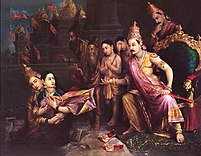Bhūmi
Bhūmi, Bhudevi, Bhūmī-Devī is the Hindu goddess representing Mother Earth. In later scripts like Puranas, she is an avatar of Mahalakshmi.[1] She is known by various names such as Bhuma-Devi, Bhuvati, Bhuvaani, Bhuvaneshwari, Avni, Prithvi, Varahi, Dharti, Dhaatri, Dharani, Vasudha, Vasundhara, Vaishnavi, Kashyapi, Urvi, Ira, Mahi, Ela, Vasumati, Dhanshika, Hema and Hiranmaya.
| Bhūmi | |
|---|---|
The goddess of Earth | |
| Member of The Pancha Bhoota | |
.jpg) Sculpture of Bhūmi | |
| Other names | Prithvi, Vasundhara, Bhudevi |
| Affiliation | Devi Avatar of Shri Lakshmi Pancha Bhoota |
| Abode | Vishnuloka/Vaikuntha, Dyuloka |
| Planet | Earth |
| Mantra | Om Bhumyai namah |
| Mount | Cow, Elephant |
| Personal information | |
| Consort | Varaha |
| Children | Narakasura, Mangala and Sita (according to Ramayana) |
| Equivalents | |
| Greek equivalent | Gaia |
| Roman equivalent | Tellus Mater |
| Manipuri equivalent | Leimarel Sidabi |
Iconography
She is depicted as seated on a platform which rests on the back of four elephants, representing the four directions of the world. She is usually depicted with four arms, respectively holding a pomegranate, a water vessel, a bowl containing healing herbs, and another bowl containing vegetables.[2] She is also sometimes depicted with two hands, the right hand holding a blue lotus known as Kumuda or Utpala, the night lotus, while the left hand may be in the Abhayamudra, the fearlessness or the Lolahasta Mudra, which is an aesthetic pose meant to mimic the tail of a horse.[3][4]
Consort
She is the consort of the boar god Varaha, an avatar of Vishnu.[5] In Satya Yuga, the demon Hiranyaksha kidnapped the earth and hid her in the primordial waters, Vishnu appeared as Varaha to rescue her. Varaha slew the demon and retrieved the Earth from the ocean, lifting it on his tusks, and restored Bhudevi to her place in the universe.
Children
Narakasura was the son of Bhudevi and Varaha. He received a boon that only his mother would be able to kill him.
According to some versions, Mangala was also born when Varaha lifted Bhumi.
Devi Sita was from the earth, thus Bhumi is her mother. Once, there was drought in Mithila, hometown of Devi Sita. Janaka, father of Sita was ploughing the ground. Under his plough , he found a baby girl (Sita). After which, rain showered and Janaka and wife, Sunaina, decided to adopt the girl. As Sita was born from the earth, she was also known as Bhumija.[6]

Killing of Narakasura
After receiving the boon, Narakasura became arrogant and proud of his power. He started capturing women and made them his wives forcefully. He captured nearly 16 thousand women. No one was able to defeat him because of his boon. Bhumi was requested to kill him. She incarnated as Satyabhama, daughter of Satrajit. Satyabhama married Krishna and they killed Narakasura.[7]
References
| Wikimedia Commons has media related to Bhūmi. |
- Anand Rao (2004). Soteriologies of India. LIT Verlag Münster. p. 167. ISBN 978-3-8258-7205-2. Archived from the original on 26 December 2018. Retrieved 22 September 2016.
- T.A.G. Rao (1997). Elements of Hindu Iconography. Motilal Banarsidass. ISBN 81-208-0876-2.
- Margaret Stutley (2003). The Illustrated Dictionary of Hindu Iconography. Munshiram Manoharlal Publishers. p. 82. ISBN 81-215-1087-2.
- A. G. Mitchell; Victoria and Albert Museum (1982). Hindu gods and goddesses. United Kingdom: Her Majesty's Stationery Office. p. 8.
- "Killing of Narakasura".
- "The Story of Mother Sita the consort of Rama". Salagram.net. Archived from the original on 30 May 2012. Retrieved 18 March 2012.
- "Happy Diwali: The Legends Linked To Deepavali Festival". NDTV.com. Retrieved 2020-06-09.
